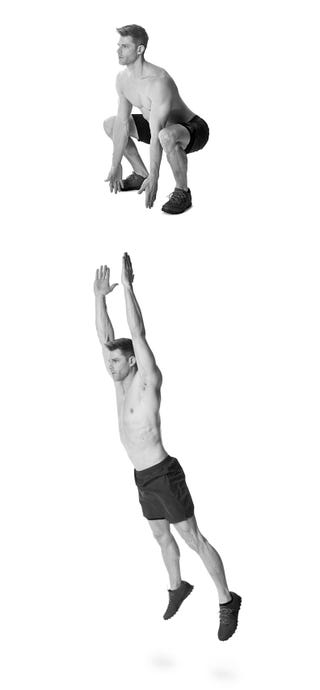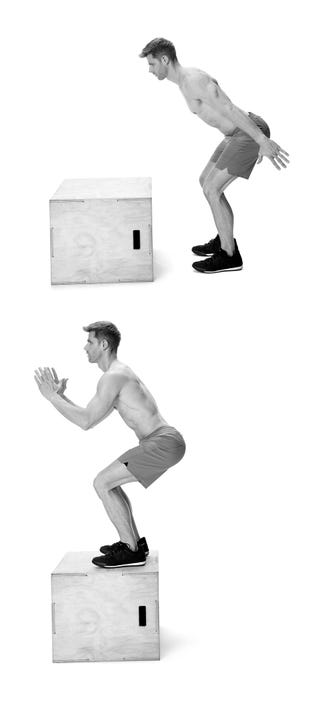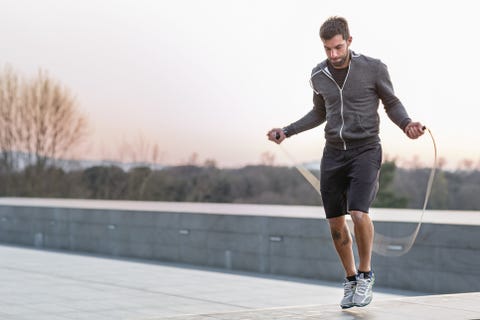
If lifting weights is like a powder keg, then plyometrics (plyos) are the match that lights the fuse.
Explosive exercises that use the muscles’ stretch reflex to build power, plyos are a staple in sports training. “They put athletes’ strength work to use,” says Zach Even-Esh, a strength coach and author. “Otherwise, they become what I call strong and useless—where you can maybe squat 405 pounds, but you can’t react quickly on the field, court, or mat.”
Plyometric training consists mainly of jumps and throwing motions. These exercises take muscles into their end ranges of motion suddenly, stretching them out. Sensing that they might be on the brink of being stretched too far, and damaged as a result, the muscles’ stretch reflex kicks in, making them contract very powerfully. Absorbing and redirecting force as fast as possible develops durability and explosiveness.
Adopting plyometric training into your own routine can make you a better athlete and help prevent sports injuries. Even if you’re not competitive with anyone but yourself, it has value. Teaching your body to recruit muscle more quickly will make you stronger on your lifts. Plus, many plyometric exercises are flat out fun to do, breaking up the monotony of conventional strength training. They may also make you better at your job, if it’s physical, and can turn you into somewhat of a superhero.
“Plyos are good for cops,” says Even-Esh. “If you pull somebody over and he takes off running, you have to be able to sprint after him on a dime. If you don’t train that kind of explosiveness, your body will forget how to utilize it.”

Men’s Health
Order Now
For a full compendium of fitness knowledge, check out the Men’s Health Encyclopedia of Muscle. The volume is chock full of workout routines, helpful training tips, and definitions for just about every gym-related term you’ve ever wanted to know.
How to Use Plyometrics
The first step is to master the most basic plyos—jumps, explosive pushups, and medicine-ball throws and catches. For the lower body, Even-Esh recommends the squat jump, frog jump, and box jump, to start.
You may feel like a kid playing again (and that’s a good thing), but these moves work. A study in the British Journal of Sports Medicine found that squat jumps, among several other plyos, increase vertical jump height. For the upper body, start with pushup variations—and feel free to get creative. The classic plyo pushup has you perform the upward phase so fast that your hands leave the floor, but Even-Esh also recommends pushups and throws.
The advantage to doing plyometrics over other forms of power training or even Olympic weightlifting movements, is the release that plyos provide—literally. “When I do a throw or pushup,” says Even-Esh, “I’m not holding onto anything, so I don’t have to put the brakes on.”
You can lift a barbell as fast as you want, but your nervous system still knows it has to slow it down at the end of the range of motion, to prevent the momentum from tearing your shoulders off. In contrast, you can chuck a ball with all your might, training your nervous system to develop maximum speed. “Plyos are also easier to learn. To teach you to do a power clean, I have to teach you to front squat and clean pull first. But, anybody can learn to jump properly in a few minutes,” says Even-Esh
Check out this list of plyo moves, which you can also find in the Men’s Health Encyclopedia of Muscle book.
Squat Jump
Stand with your feet at shoulder width and your toes turned slightly out. Without letting your feet actually move, try to screw both legs into the floor, as if you were standing on grass and wanted to twist it up—you’ll feel your glutes tighten and the arches in your feet rise. Take a deep breath into your belly, and lower your body down quickly. Push your knees out as you descend. Go down until your thighs are parallel to the floor, and then immediately explode upward, jumping as high as you can. Land softly with your spine long, chest facing forward, and knees still pointing out. Reset before you begin the next rep.
Frog Jump

Mitch Mandel
Squat down with your arms extended between your legs until your fingers touch the floor. Explode up and forward, reaching upward with your arms as you rise. Land with control, and use the momentum to begin the next rep.
Clapping Pushup
Clap your hands together when you’re in mid-air, or slap your chest.
Close to Wide Grip Pushup
Start the movement with your hands close to your sides and, after you press yourself up into the air, land with your hands outside shoulder width.
Staggered Pushup
Have one hand a few inches in front of your shoulder and the other hand a few inches behind the opposite shoulder and alternate hand placement every time you land.
Medicine Ball Crossover Pushup

Mitch Mandel
Place one hand on a medicine ball and switch hands in mid air so you land with the opposite one on the ball. Keep your core tight and your pelvis in line with your spine. And, think speed—your hands have to get air, or it’s not a plyo. As soon as you land, allow your body to descend to the bottom of the next rep and push back up again as hard as you can.
Rotational Throw
Stand perpendicular to a wall and a few feet back. Hold the ball with both hands. Twist your torso away from the wall, pivoting on your front foot. As you wind up, reach your arms out—you should feel a stretch in your side. Twist back and throw the ball into the wall as hard as you can. Keep your spine long throughout the movement—don’t slouch or bend forward.
Punch Throw
Set up as you did for the rotational throw, and squeeze the ball with both hands. Powerfully twist toward the wall. Your shoulders and hips should turn at the same time. Release at the end of the twist, throwing the ball into the wall with your rear hand as if throwing a punch. If you have a partner, you can spread out, and take turns throwing the ball to each other, which is even more challenging—you’ll have to catch and slow down your buddy’s throw before you fire the ball back.
Box Jump

Mitch Mandel
Start with a small box or platform. Swing your arms back to gather momentum and jump onto the box, landing with soft knees. You should land in a quarter-squat position. Have a smaller box set next to the one you’re jumping onto, and step onto that small box first, before you return to the floor. Never jump down.
Even-Esh can’t emphasize enough the proper way to dismount. “I hear a lot of stories about people rupturing their Achilles tendons in exercise classes,” he says. So, forget what you’ve seen on YouTube of people jumping off boxes back to the floor and jumping up again immediately. Gradually, move to higher boxes as you warm up. When you’re ready, you should use a box that’s somewhat challenging to jump up onto, but not so high that when you land, your knees are at your chest. The point is to develop explosiveness, but with control and safe technique. Don’t try to set a world record.
Slower Starts

Getty ImagesInnocenti
Of course, other classic exercises that have a rebounding component can be considered plyometrics, as well. If jumps and pushups above too advanced for you, Even-Esh says jumping rope can be a great start.
You can also run sprints, although he recommends that you do them up a hill rather than on flat ground, which will slow you down enough to lessen the risk of a pulled hamstring. “Start your sprints from the top of a pushup position,” says Even-Esh, which encourages you to lean forward as you rise up to run, putting you in the best biomechanical position to go fast.
You can also begin a sprint lying on your back. Have a partner yell “go” or set a timer to go off , then spin around, get up, and run. Finally, medicine balls make for user-friendly upper-body plyos. Take a 4- to 10-pound ball and throw it against a brick wall, or raise it overhead and slam it into the floor. You can catch it on the rebound if the ball has a hard shell, or pick it up, and repeat.
Try standing over the ball and squatting down to grab it, then jumping up and throwing it overhead as high as you can, called a scoop throw (you’ll have to do this one in a big, empty area, or outside). (Rotary movements are also popular among baseball players chasing greater bat speed, and fighters who want to deliver knockout punches.)
The Nitty Gritty Details of Plyometric Training

Getty ImagesJakob Helbig
Plyometrics have to be explosive, and the form you use must be sharp. Therefore, the number of reps you do will generally be low—before fatigue sets in, making you slow and sloppy. If you want to develop maximum power in the weight room or for sports like football, basketball, and baseball, Even-Esh suggests keeping your reps for all your plyos in the range of 12 to 24 total.
“That could break down to 12 sets of 2, 5 sets of 5, or 5 sets of 3,” and many other combinations, he says. If you feel yourself slowing down or breaking form at any point, end the set and rest, as needed. Limit your plyometrics to one to three exercises per workout, and do them first—either at the end of a Dynamic Warmup or before you get into your heavy or more metabolic training. You can also alternate them with sets of heavy lifts.
Plyos can be a form of cardio, too. Here’s a game you can play: Take a medicine ball outside, and simply throw it as far as you can. Run to it, pick it up, and throw it again. “If somebody is training to run a Spartan race,” says Even-Esh, “I might have them do some moderate-intensity throwing in some higher-rep ranges.” Set up a circuit of 30 to 50 total reps—for example, 10 overhead throws to a wall, 5 reps each side of rotational throws, 5 scoop throws, and 10 slams into the floor, repeated for 3 to 5 rounds. “This gives him power-endurance,” the ability to be explosive repeatedly over a long period of time, he says.
Source: Read Full Article
